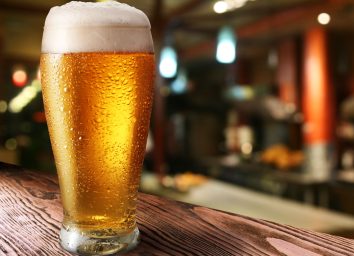5 Best Eating Habits To Combat Seasonal Depression

If you’re someone who experiences depression or depressive symptoms that seem to sync up with the changing seasons, you may possibly have seasonal depression, or what is also known as seasonal affective disorder (SAD). SAD typically occurs in the winter months, with symptoms often starting around late fall as the days get shorter and the weather gets colder and lasts till the following spring or summer. Although less common, the opposite can also happen, where this form of depression rears its head in the spring or summer, subsiding by fall and winter.
Common symptoms of SAD include feelings of sadness, moodiness, low energy or sluggishness, difficulty concentrating on daily tasks, and an overall feeling of hopelessness. While SAD is characterized by the propensity for these symptoms to resolve with the changing seasons, the cyclical nature of this mental health condition can be difficult to face on a yearly basis.
There’s no simple, direct cure to treat this condition. (And if you suspect you or someone you know is struggling with a particularly severe case of SAD, it’s imperative you consult a healthcare professional to discuss an effective treatment plan that may incorporate therapy or even medication.) That said, there are healthy ways to help cope with SAD-associated symptoms. According to the Cleveland Clinic, getting regular exercise, spending time outdoors, getting adequate sleep, and eating a balanced diet can help you manage SAD symptoms.
“While there is no one diet to help you avoid seasonal depression, they are some foods and tips you can incorporate to help ward off its symptoms,” says Amy Goodson, MS, RD, CSSD, LD, the author of The Sports Nutrition Playbook and a member of our Expert Medical Board.
Read on to learn some dietitian-recommended eating habits that you can incorporate into your daily routine to help deal with seasonal depression as it arises.
Eat more vitamin D-rich foods

Though a crucial vitamin to have, we’re more we’re likely to lose out on vitamin D when we spend more time indoors—something that becomes especially common as days grow shorter and temperatures drop.
“One of the main reasons we experience seasonal depression is due to a lack of sunlight and vitamin D activation,” says Goodson.
“Research has shown that people who are deficient in vitamin D are more likely to be depressed, and there may be a link between vitamin D deficiency and specific mood disorders like seasonal affective disorder,” says Tammy Lakatos Shames, RDN, CDN, CFT, and Lyssie Lakatos, RDN, CDN, CFT, also known as The Nutrition Twins.
According to the Mayo Clinic, it’s recommended that adults get around 600 micrograms of vitamin D a day.
“Foods like cow’s milk, fatty fish like salmon and trout, and eggs,” Goodson suggests, if you’re looking for easy sources of vitamin D. For plant-based sources of vitamin D, you can also find orange juice fortified with vitamin D at your local grocery store.
However, getting enough vitamin D is still tricky to do through food sources alone. So, if possible, try spending some time in the sunniest part of the day. Additionally, you can make sure to get your daily dose of this vitamin by trying a vitamin D supplement, as well.
Get plenty of protein at every meal
According to the Nutrition Twins, getting plenty of protein throughout your day can help you manage symptoms that come along with seasonal depression.
“Protein raises your body’s feel-good chemicals, serotonin and dopamine, so getting a boost consistently throughout the day is important,” claim the Nutrition Twins. “Eating protein with meals also helps to keep energy levels on an even-keel, preventing the blood sugar dips that trigger mood swings.”
The Twins recommend about 20 grams of protein per meal, if possible. However, this can sometimes prove challenging when on the go, especially with consideration to the other food groups. If this sounds like you, know that protein doesn’t always have to serve as the star of your entrée and consider working it into your meals as a side dish or additional ingredient to top your main dish.
“Some ideas for getting protein at your meals are eggs or Greek yogurt with your cereal or toast at breakfast, beans and chicken in your salad at lunch, and chicken or shrimp in your pasta at dinner,” the Nutrition Twins recommend.
Limit your intake of processed food and added sugar

“Simple sugars often found in processed foods and snacks can cause an increase in blood sugar, which might make you feel good for a moment, but typically leaves you feeling down and in an energy slump later,” says Goodson. “Those energy lows can magnify other depression symptoms you may be experiencing.”
Research has found that consistent consumption of added sugar and processed food may have negative effects on your mental health as a whole. A study published in Scientific Reports found an association between sugar intake and increased symptoms of depression. Another study from The British Journal of Psychiatry found that participants who regularly consumed higher amounts of sugar and processed foods were more likely to have depression symptoms. While these studies were not linked specifically to SAD symptoms, these findings do suggest that limiting processed foods and sugar may be able to help you manage overall symptoms associated with depression, in general.
Have at least two cups of leafy green vegetables per day
The Nutrition Twins suggest incorporating at least two servings of leafy green vegetables into your diet every day.
“These vegetables are a good source of folate, and research shows that low levels of folate are linked to depression,” says the Nutrition Twins. This is speculated to be because “folate deficiency may impair the metabolism of neurotransmitters that are very important for mood, including serotonin, dopamine and noradrenaline,” they continue.
“Any leafy green like spinach, kale, bok choy, turnip greens, or romaine lettuce, and other sources of folate include beans, oranges, asparagus, avocado, and broccoli,” the twins advise, with regard to finding quality food sources food sources of folate.
Eat smaller meals on a more frequent basis
A common symptom of SAD is lethargy and a lack of energy throughout the day. In order to combat this, Goodson suggests eating smaller, more frequent high-fiber and protein-enriched meals throughout the day.
“Fueling your body with protein and high-fiber foods often throughout the day can help stabilize your blood sugar levels, and thus your energy levels, as well,” says Goodson. “When you are under-fueled or tired due to a lack of nutrients, all of life’s other stressors are often magnified, making it harder to cope with day to day things.”
While you can’t totally avoid seasonal depression, following these eating habits, getting plenty of movement, and spending time with those you love can help alleviate some of the symptoms associated with it.








